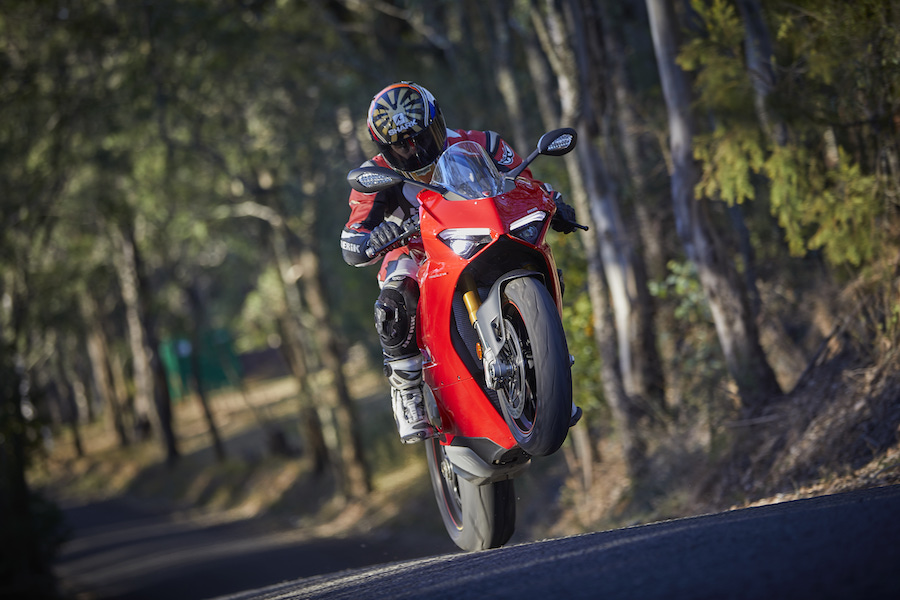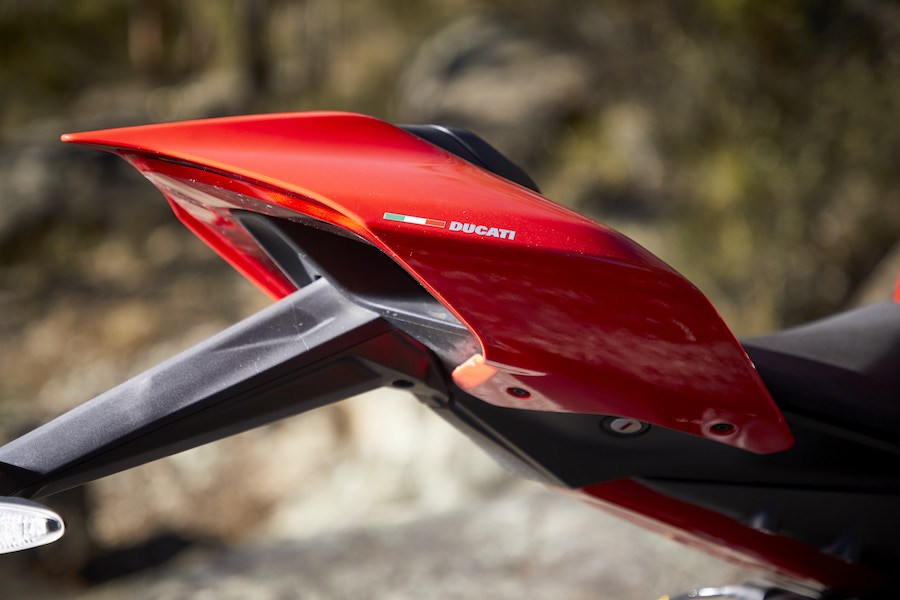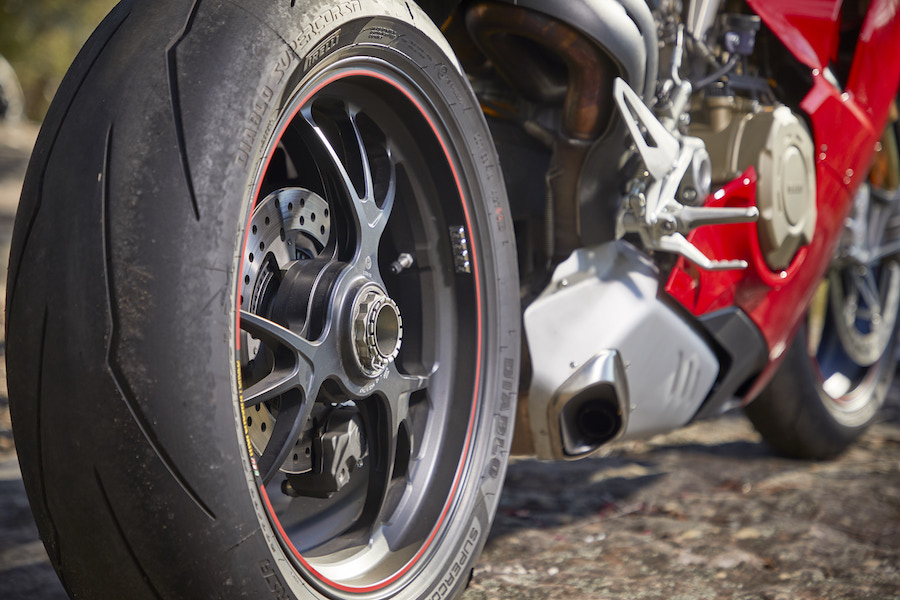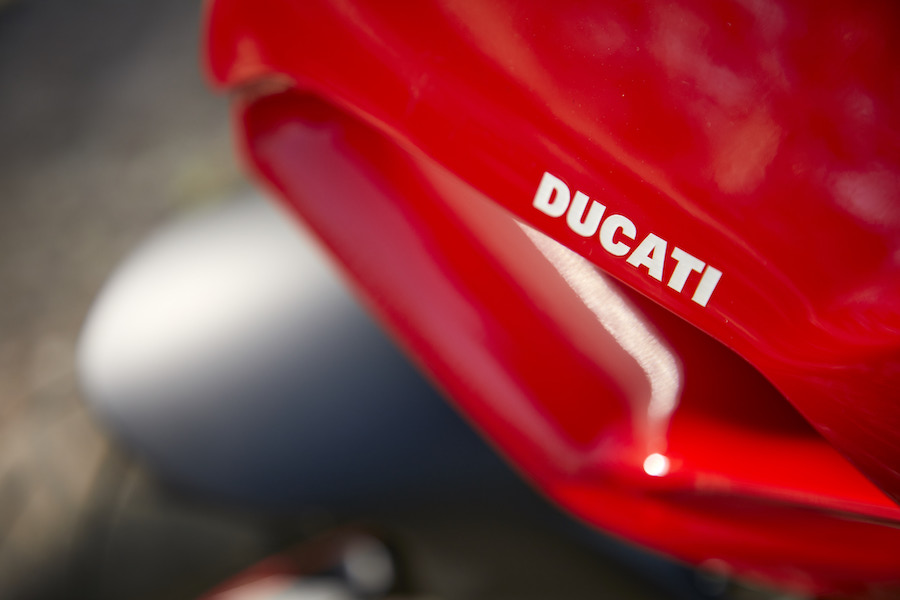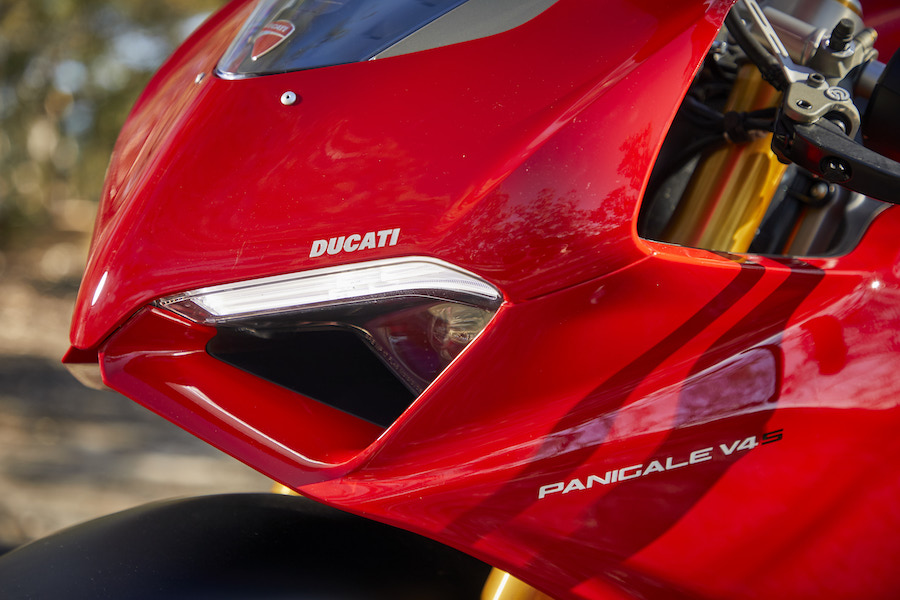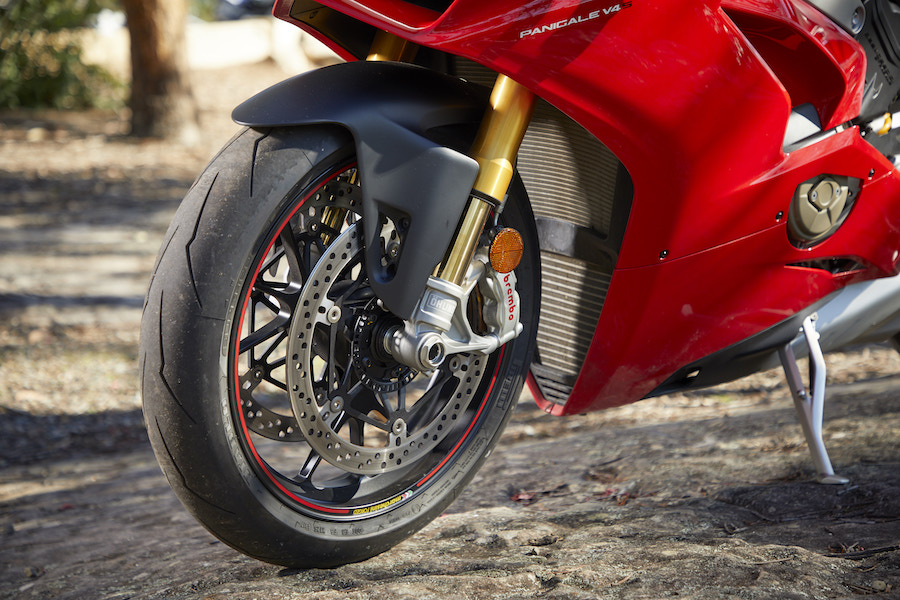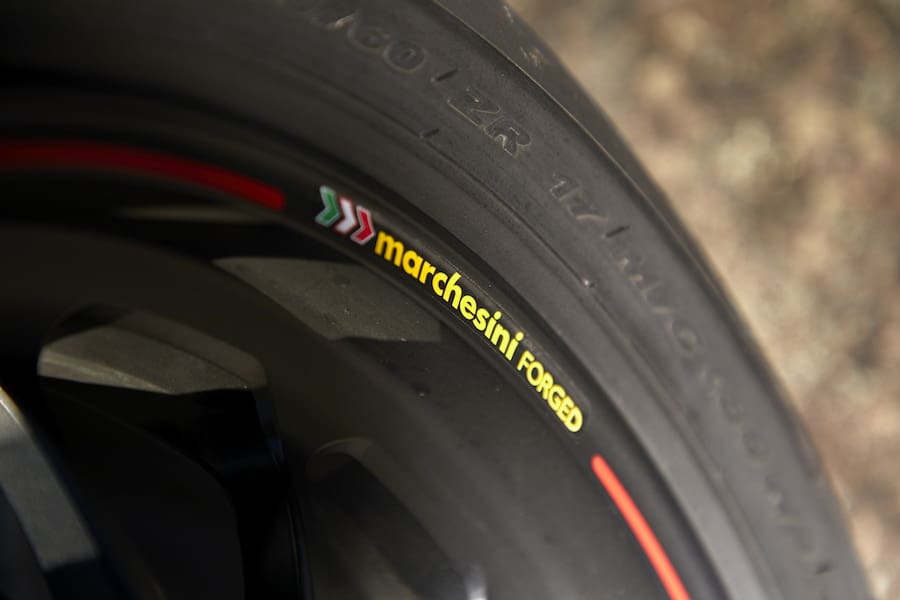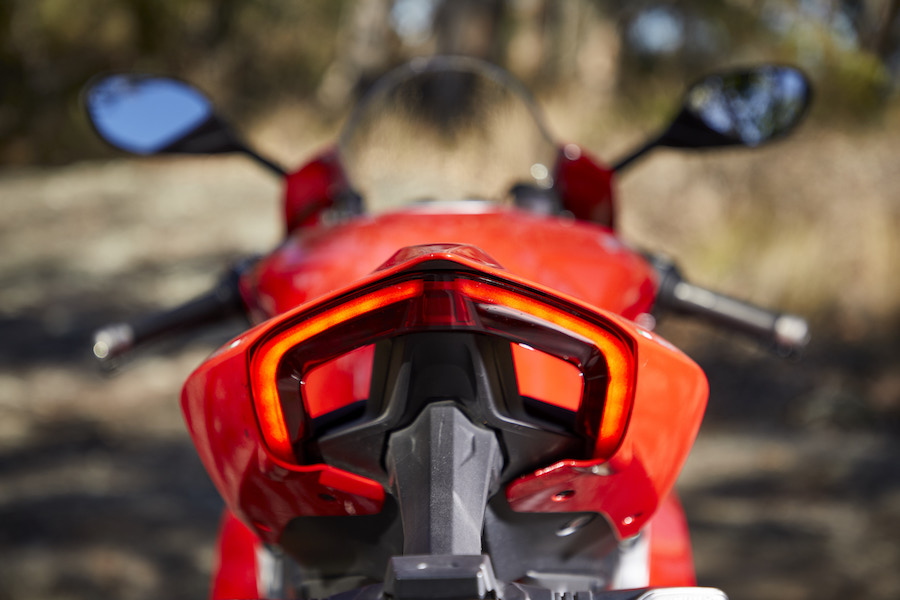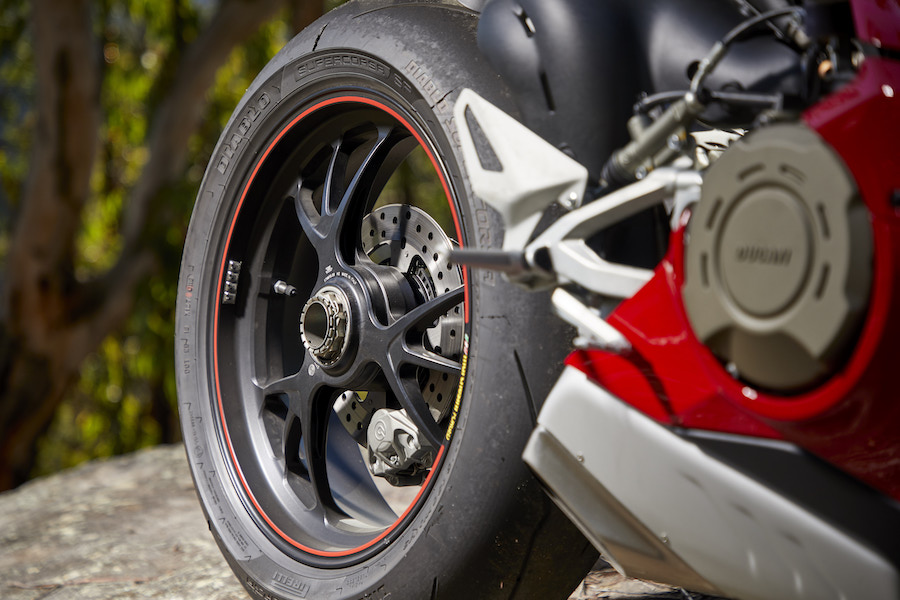It’s one of the sexiest bikes on earth – but does it belong on the road?
Everything was going light – the front wheel, my head, my grip on reality. Not coincidentally, this lightness of being was accompanied by the most insane V4 I’ve ridden, getting all shouty at the top of its rev limit. I would have been all shouty in my helmet too, if I could get the breath to do it.
But we know the new Ducati Panigale V4 S is fast; Dobie found out all about that at the track launch of the bike at the start of the year. Yep, its 158kW (214hp) top-end feels every bit like a racer with lights. Incredible.
The key bit is that it does have lights, but is it worth using them on the road? Does Ducati’s fastest bike have any place among the traffic en route to a greasy backroad you call your favourite? How many compromises do you have to make to park a two-wheeled supercar outside your local coffee shop?

I honestly cared not for the compromises during my first few days on this animal because, well, it’s an animal. The engine talks to you, making a variety of noises that both intrigue and delight, and that changes depending on mode, use and gear. The brakes made me laugh out loud each time I gave them a squeeze. The suspension is incredibly compliant for what this bike is and, again, the sounds it makes has the rider in you yearn to be playing with the throttle just to make it grunt at you. So good.
How Ducati has made the switch from a V-twin company to a V4 one is genius. Of course, having its MotoGP bikes known for their V4’s top end helps, and the road-going Desmosedici before this weapon set our expectations, but to embark on a new heart from that which for you are known is brilliantly brave – and has certainly paid off.
Trundling around in the bottom end isn’t frustrating like the original 916 could be with its heavy clutch and an engine that didn’t want to play ball smoothly down low. And it’s better than the 1299. This one delivers crisp throttle response from the rev basement, particularly in Street mode, and the up-and-down quickshifter lets you just use the clutch without too many confused interjections from the electronics.
Naturally the bike feels better once it’s got the shopping trolleys out of its way and is moving more freely, but what bike doesn’t?
The biggest barrier to the low-speed stuff is the heat erupting from that excellent engine. It takes energy to make that much horsepower and, with two of the four cylinders pretty much under the rider, the bike could heat a small town with the thermal energy it produces from under that seat.Even on the cold winter days I spent on this bike, the heat was a distraction – even in Kevlar jeans. It gets proper hot.
The seat itself is much better than I could have hoped for on a rabid sportsbike like this one. Seat technology has largely been shadowed by the advent of other more exciting tech developments, but given that we sit on these things for a long time, a good seat is a big part of enjoying a bike. For what this bike is, the seat is great, even if it all gets a bit hot under the legs.
While a hot engine is to be expected with that much power on tap, it’s Ducati’s management of that power that is really impressive. Yes, this
bike has an insane amount of horsepower, but before you find yourself praying for the electronics to help you out, the old-school attributes of throttle response, tractability and predictability come into play.
This bike would lever itself up and over that rear axle at every sniff of throttle if Ducati hadn’t spent so much time on the chassis balance, but it is still a nimble and tactile beast in an environment where it really shouldn’t be, and that’s in the traffic you need to deal with in order to get to the fun bits.
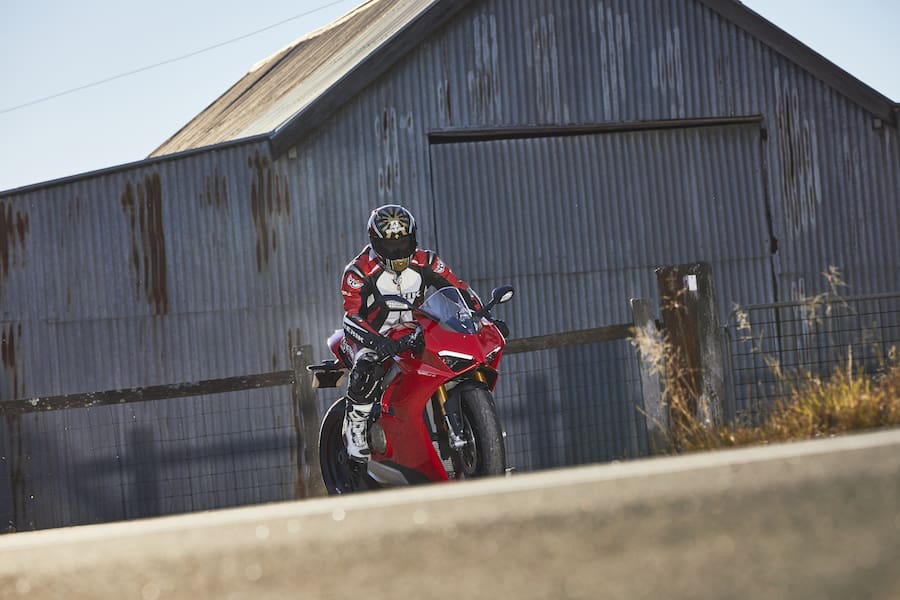
Once you have this bike in its preferred environment – stitching corners together – you wonder how fast you have to go to really push the bugger, and you realise all the inputs you have are being aided by the bike’s superb levels of feel.
The throttle begs you for more, just because playing with the loud tube results in the kind of noises and forward propulsion you only ever imagine a WorldSBK pilot feels, but it does it with measured responses.
This isn’t a beginner’s motorcycle, far from it, but experienced riders will love the way this bike talks to them.
On unpredictable public roads, the feel from the bike’s engine and well-sorted chassis is gold. It’s no sports tourer, but the ability to dial in a happy compromise between high-end sportsbike and public road parameters is excellent. This is also where the well-sorted electronics package comes into its own.
There are so many layers of adjustment, only the most ardent bike nerds will shuffle their way through them all, but Ducati has chosen to set them out in a really easy-to-decipher manner, using real-world language, rather than the compression and rebound terminology that encourages many riders to never go near their suspension adjustment.
You can choose Brake Support, for instance, and then dial in more ‘Comfort’ or the other way, with more ‘Stability’. That’s easy to understand, even if in reality it’s just a different set of words to describe the same thing.
The pair of Öhlins on the V4 S are as good in dealing with the bitumen as they look, creating a balanced and solid-feeling rocketship – just how I like my spacecraft. This is the best-turning Ducati I have ridden on the road; I love how light the steering is, even while the front wheel feels certain to stay where you put it.
Even as you turn, the bike is helping you dial in grip as the computer and sensors have a right old party determining when to add and subtract damping depending on which part of the corner the bike calculates you’re in.
The only part of this wizardry I’d like to see improved is the addition of electronically adjustable spring preload. The Panigale only adjusts damping with the computer, but for me preload is an important part of the suspension dynamics. You can manually adjust front and rear preload, and weight and complexity probably affected Ducati’s decision not to include it.
As it stands, though, the bike is a phenomenal handler on all kinds of roads, considering what it is. Yes, a sports tourer or adventure bike would handle the bumps better, but they look, sound and go a long way different from this thing. So take your pick.
For a top-end racer with lights, the V4 S cuts an astounding swathe through Aussie backroads.
When the bike did get hot from too many low-speed U-turns for the photographer, it did get a bit grumpy, and the engine felt like it was running itself on two of the four cylinders as a heat-reducing measure, which made it sound all kinds of weird. It remained useable, but it was the first time I felt like the bike was riding me a bit, instead of the other way around.
The engine is designed to drop to two cylinders at idle under 1800rpm, to reduce running temperature, but not when it is being ridden, so Ducati was surprised when I mentioned it did it while I was riding – it sounded like a pit lane speed limiter – but that’s what it did. It didn’t hamper the fun, though it did make a whole new aural sensation on what is really an astounding sounding bike.

Another factor in that beautiful note is the bidirectional quickshifter. The bike is designed to sound like a V-twin, thanks to the counter-rotating crank having 70° offset crank pins and a twin-pulse firing order of 0°-90°-290°-380°. It crackles, spits and grunts depending on how you use it. Knocking out two downshifts as it cackles into a corner is one of life’s great pleasures, as is feeling the insane engine build revs obscenely quickly beneath you on the way out, followed by a meaty pop as you feed it another cog – if you’re brave.
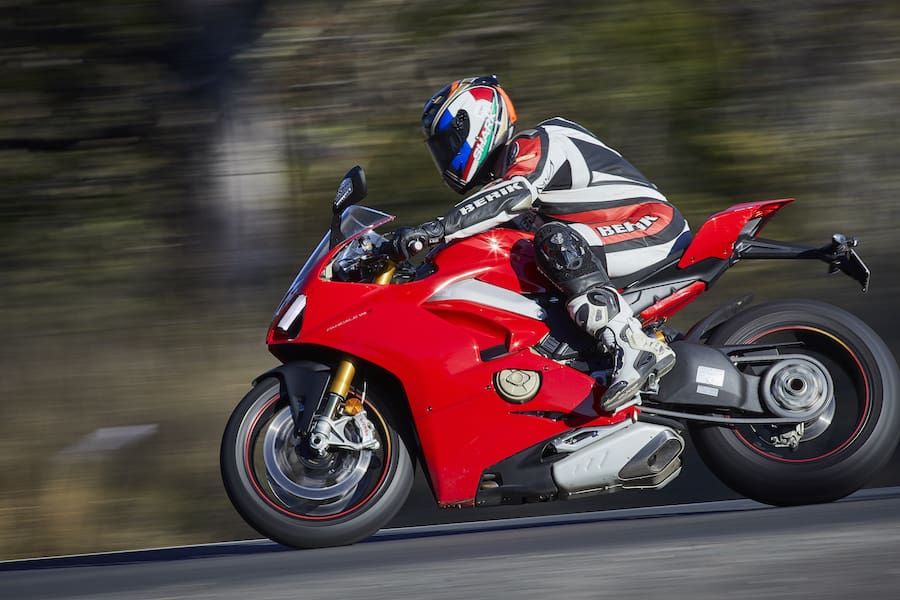
Other need-to-knows that are important for road use include: 120km/h on the speedo is around 5200rpm in top gear; the mirrors aren’t the cleanest items image-wise and vibes are present, but not unpleasantly so; and for a sportsbike, the ride position is very un-Italian in that it’s as real-world practical as a sportsbike gets.
The really street-friendly side of this bike is the attention it gets. Tourists took pics of it at Wisemans Ferry, then some muppet hung out of his car in the Sydney CBD and asked if it was “that new f***-off V4?”
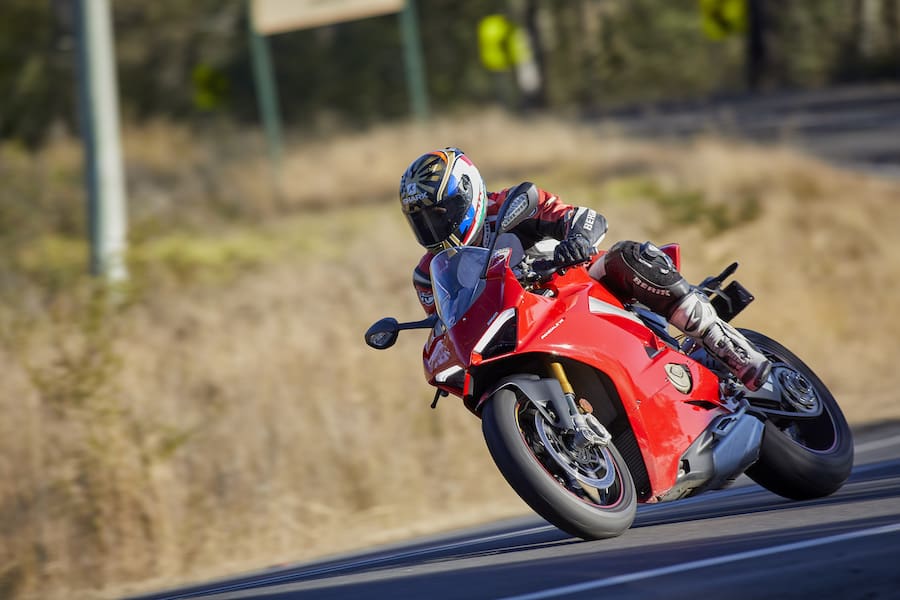
Does it have too much power for the public road? Not in Street mode it doesn’t, assuming you use its torque to get you around. If you choose full throttle as part of your daily commute, then it is too much – but that’s technically true of anything with more than 80hp when ridden that way.
Right next to that astounding throttle tube is the just as remarkable front brake lever. Oh my god, these brakes are soooo much better than me – feel, power, finesse… they have it all. Absolutely faultless, as you’d expect from Brembo’s top-shelf Stylema caliper and 330mm twin disc combination.

Dialling in an ABS system to cope with that amount of braking force must have been tricky; a lesser system would just assume the bike needs intervention all the time, given the rear wheel gets so light, but the V4 S can stop better than almost anything on two wheels, I reckon. I can’t fault those brakes on the road and my only regret was not getting them to grief on a racetrack. But honestly, I don’t think I would have taken them too close to their own astounding limit anyway. They’re incredible.
With the right riding mode – I used Street most of the time; Sport and Race are fun too, just not as sensible – the Öhlins suspension dialled down to Comfort where applicable, and leathers on instead of jeans to mute the heat coming out from under the seat, this is a very streetable Ducati sportsbike. Who woulda thought?
The sheer cleverness of the V4 S is backed by solid componentry that works hard to keep you engaged as a rider, whether you are at Mach 2, or just tolerating the commute home. I found I could amuse myself in a range of ways – sitting there dialling in suspension adjustments via the easy to use dash and toggles, kicking new gears unnecessarily up and down, particularly when in tunnels or adjacent to sandstone walls, giving the thing its head and feeling the fear as the world goes loud and blurry, nailing the front Pirelli to the floor with those astounding Brembos… I could go on. Simply putting in a favourite road ride is a combination of all of those things, and it adds up to two-wheeled blissfulness.
Yes, it can get a tad burny from the bike seat, I jammed my thumb a few times doing full-lock U-turns, and there’s more power than I could ever justify having… but damn, this bike makes me feel so good riding it.
It is responsive, offers incredible feedback, has electronics I am happy to have on my side, makes sense of complex adjustments, and is simply an incredible sportsbike for the road. You’d be mad not to do track days on it, but if your usual diet is roads you won’t be trading it in on a Monster any time soon.
While the entry ticket price is hefty – $37,490 plus on-road costs, though you can purchase the standard bike for $28,900 plus ORC – this is the best bike in its class. Kawasaki’s ZX-10R SE is a sweet machine and is around $7490 cheaper, but it doesn’t have the same performance level as this crazy Italian does.
Road-going track refugees are better suited to the open road than ever, thanks to engine tractability and manners, compliant, electronically adjustable suspension and parachute-style electronics. If you want the best sportsbike available today, get this one. And don’t be afraid to use the number plate.
Worlds Sam Maclachlan
Photography Josh Evans
